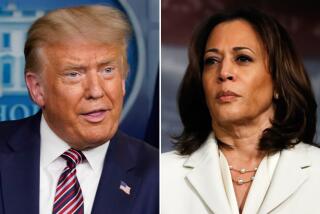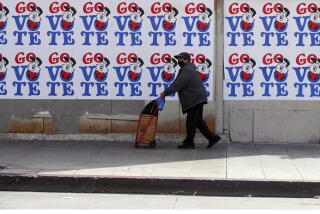New section, same goals
- Share via
TODAY, the opinion pages move to the first section of the newspaper. Except on Sundays, when we will continue to be part of the Current section, editorials will be published on the third-to-last page of Section A. Although our staff is not part of the newsroom at The Times, and our pages are separate from any other part of the newspaper, we think it makes the most sense for editorials and Op-Ed articles to appear in the one section that includes news articles about all subjects -- local, national, international, business, cultural, sports and so on -- because our focus on these pages is equally broad.
The move offers us an opportunity to reintroduce ourselves and let you know what we’re about. That is why today’s editorial above this note is not about the mayor, or Iraq, or federal regulatory policy, but rather an explanation of this page’s general philosophy, the principles that inform and guide all our editorials.
But what exactly is an editorial? The simple answer is: an unsigned article expressing the newspaper’s opinion on a matter of public interest.
Elsewhere on these pages are notes by Nick Goldberg, the Op-Ed and Current editor, and Julie Green, the letters editor. They explain that the Op-Ed page hosts a wide range of viewpoints provided by our columnists and outside contributors and that the letters section is for our readers to weigh in. Those are spaces where we invite others to make their points -- we provide the hall, if you will, where others come to debate. In contrast, the space you are now reading is the one place in the newspaper where The Times tells you what it thinks as an institution.
Speaking on the newspaper’s behalf is the editorial board, consisting of nine writers and three editors. (To meet the members of the board, go to latimes.com/edboard.) With a few of us on the phone -- two writers are in Washington, one is in Orange County -- we meet three times a week at a blond-wood conference table. Each of us comes to those 10 a.m. meetings with areas of expertise and a sense of which issues we think the page should address. In the course of the next hour or so, ideas and arguments will be batted around, examined for flaws, pushed in new directions, (sometimes) discarded entirely and (ideally) molded into coherence. Meetings can meander. Anyone is free to chime in. A discussion about medical marijuana or offshore oil drilling may lead to a debate about the proper balance between state and federal power. The latest celebrity gossip can lead to a conversation about the pros and cons of Hollywood’s strategy for distributing movies over the Internet.
We often have visitors. In recent weeks, more than four dozen candidates seeking endorsement have made their way to our conference room. So have the mayor, Britain’s prime minister and the chairman of the Federal Communications Commission, to name a few.
Members of the board are influenced not only by who they meet and what they read but by their own reporting. We interview sources much like our newsroom colleagues, even though we aren’t likely to use quotes. We go wherever our interests lead us -- skid row, Sacramento, Shanghai -- and what we learn informs and sometimes changes our opinions. We’re not entirely free to write whatever we want, however. The editorial board imposes a few institutional constraints, by design.
One is what is known in the law as stare decisis. Our past positions on any given topic help guide our present view. It would be intellectually inconsistent, not to say politically opportunistic, to favor term limits when one party is in office but oppose them when another governs. (For the record, we don’t like term limits for anyone.)
None of us is quite so pretentious that we would resort to quoting Emerson -- something about consistency and hobgoblins -- in a meeting. (Our cultural references are actually pretty varied; I recently learned from my colleagues that there is a recording artist named Pink.)
The writing of editorials is a team effort; they aren’t columns reflecting any one person’s viewpoint. A member of the board (myself included) can’t write an editorial endorsing a position in the absence of consensus among the group. That is not to say we are a full democracy. My deputy editor, Michael Newman, and I have a bigger say. And we report directly to the publisher, so he has an even bigger say. (But don’t worry, he doesn’t like term limits either.)
Sometimes, if the board is stalemated, we may decide not to say anything at all, at least for a while. But we usually have something to say, and pass on plenty of tempting items given that we typically weigh in on only three issues a day.
We are also spreading our voice outside the geographical constraints of this page. Through the public-affairs lecture series Zocalo (zocalola.org), we have held several stimulating public discussions with board members, guest speakers and some of our 10 regular Op-Ed columnists. We increasingly will be offering more online-only content, whether rebuttals to an editorial or virtual chats with a columnist. We also maintain a lively group weblog called Opinion L.A. (opinion.latimes.com), where we sample the local conversation and invite readers to weigh in, even (or especially) if it’s to tell us to do a better job.
When we’re doing our job right, though, we are a clear and forceful voice in the community. We don’t expect you to always agree -- we’d be out of business if you did -- but we do hope to earn your respect. And when you want to voice your disagreement with us, please do so. Julie, our letters editor, will be thrilled.
ANDRES MARTINEZ
Editorial Page Editor


